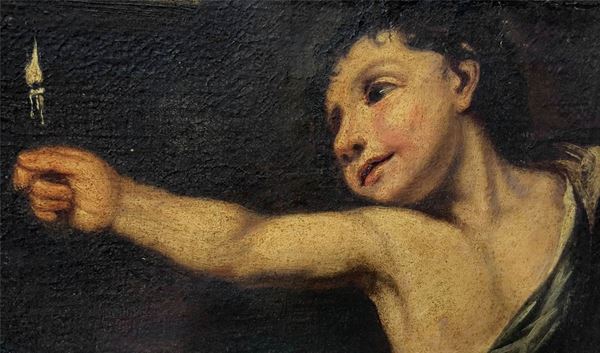19
Oil paintinging on canvas depicting Parca Clotho and boy with candle, seventeenth century. Cm 61x80. With no frame. "The work is orally allegedly by Venetian painter Pietro della Vecchia (Vicenza, 1603 - Venice 1678). Known as Peter Muttoni until 1984, as a result of misinterpretation of Abbot Luigi Lanzi, achieved fame around the end of the fourth decade of Seventeenth century, to be considered one of the most important painters of Venice, especially of religious art, and a great connoisseur
Oil paintinging on canvas depicting Parca Clotho and boy with candle, seventeenth century. Cm 61x80. With no frame. "The work is orally allegedly by Venetian painter Pietro della Vecchia (Vicenza, 1603 - Venice 1678). Known as Peter Muttoni until 1984, as a result of misinterpretation of Abbot Luigi Lanzi, achieved fame around the end of the fourth decade of Seventeenth century, to be considered one of the most important painters of Venice, especially of religious art, and a great connoisseur of ancient drawings and paintings, the head of a large workshop. Its first activity is affected by the Venetian Carlo Saraceni color painting and Padovanino Padovanino, until suffering the influences of painting by Giorgione, Titian, Romanino, Palma il Vecchio, the Bassano and the Genoese Bernardo Strozzi, the latter landed in Venice in those years '30. After 1650 his art turns toward a wise and prevalent use of light, therefore, towards a greater drama, and resumes the first caravaggeschi models. It undergoes the fascination libertine atmosphere, vaguely subversive and anti-clerical, featuring the Academy of Incogniti, created by Venetian nobleman Giovan Francesco Loredan and frequented by a diverse mix of intellectual free thought, not only from Veneto. These influences are particularly apparent in the iconography of some works of the mid-century, which tend to ridicule, to represent so grotesque, so challenging, the official and dominant culture. The painting probably depicts the frugal Cloto, whose name derives from the greek Klothes, spinner, who spins the thread of life, or the thread of fate. In Hesiod's Theogony, it is the inescapable fate, along with Lachesis and Atropos sisters, that thread play and finally severed, marking the life and death of every man. Clotho, who works tirelessly day and night, illuminated by the candle boy, is also evoked in the Purgatorio of Dante, Canto XXI, 25-27: "But because she who day and night in a row, He still did not had the distaff, Which Clotho lays for each one and ... " The evocative theme, the grotesque and realistic representation ruthlessly, the effects of spectral lights and the suffocating lack of space in the composition, then bring back the painting to the years and the atmosphere of the Academy of Incogniti, as well as the "Group of Gloomy," which They were lucky to Venice around 1660. The assignment could be confirmed by comparing the work with the secure creation of Peter the Old, representing The Three Fates with skull and preserved in Galleries Estes. "ASOR Studio
€ 1.500,00
Starting price
Mot provided










